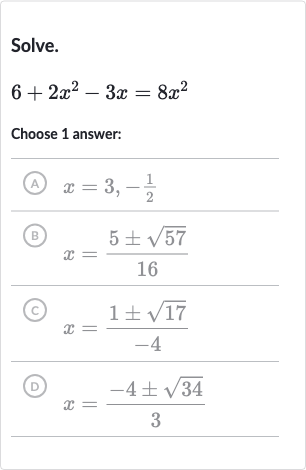AI tutor
Full solution
Q. Solve.Choose answer:(A) (B) (C) (D)
- Setting the equation to zero: First, we need to set the equation to zero by moving all terms to one side.Subtract from both sides to get:Rearrange the terms to get a standard quadratic equation form:Now, we can multiply the entire equation by to make the coefficient positive:
- Rearranging the terms: Now, we will use the quadratic formula to solve for . The quadratic formula is:For our equation, , , and .
- Using the quadratic formula: Let's calculate the discriminant (the part under the square root in the quadratic formula):Discriminant = Discriminant = Discriminant = Discriminant =
- Calculating the discriminant: Now we can substitute , , and the discriminant into the quadratic formula:
- Substituting values into the quadratic formula: We can simplify to get the exact solutions:Since cannot be simplified to an integer or a simple fraction, we will leave it as is.
- Simplifying the square root: Now we have two possible solutions for x: or These are the exact solutions in their simplest form.
More problems from Solve a quadratic equation using the quadratic formula
QuestionGet tutor help
QuestionGet tutor help
QuestionGet tutor help
QuestionGet tutor help
QuestionGet tutor help
QuestionGet tutor help
QuestionGet tutor help
QuestionGet tutor help

